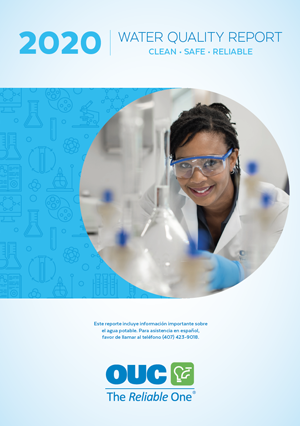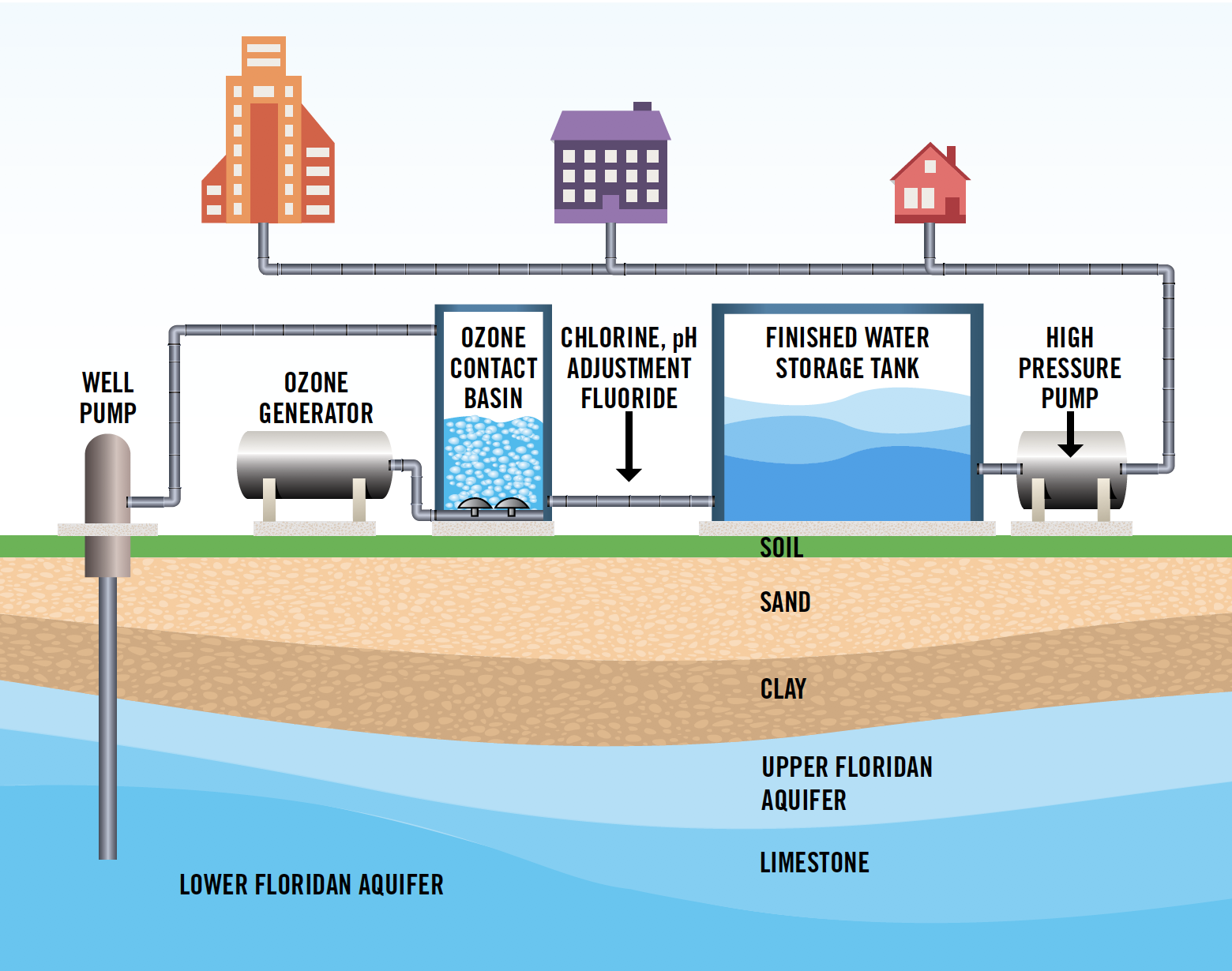2020 Water Quality Report
 CLEAN • SAFE • RELIABLE
CLEAN • SAFE • RELIABLE
A Naturally Clean Water Source
OUC’s water comes from the Lower Floridan aquifer, an underground reservoir that, in many places, is a quarter-mile below parts of the Earth’s surface. The aquifer is fed by rainwater that goes through a filtration process as it seeps through hundreds of feet of sand and rock. OUC pumps water from the aquifer to facilities where it’s treated to meet standards that ensure the water is safe to drink.
Promoting Water Conservation
OUC works year-round to educate the community about the importance of protecting such a precious — and limited — natural resource. From water-conservation themed events, campaigns and student projects to proactive traditional and social media outreach during times of low rainfall or drought, we are committed to helping our customers understand the vital role water plays in everyday life and how crucial their role is in protecting it.
OUC also offers services that help customers become water-wise consumers. Our conservation team conducts home audits to search for potential sources of water loss and make recommendations on improvements. Some recommended upgrades are eligible for OUC rebates, including low-volume irrigation systems, ultra-low-flow toilets, and water cisterns. Customers also have online access to water conservation tips and videos covering such topics as leak detection, water-wise landscaping, faucet aerators, and more. For additional information, visit OUC.com/water.
Ozone Process Produces Great-Tasting Tap Water
OUC uses ozone treatment at our seven water-service plants as part of a process to produce high-quality, great-tasting tap water we call H2OUC. Ozone oxidizes hydrogen sulfide to improve taste, eliminate odor and reduce the amount of chlorine that’s added to water. By law, we are required to add chlorine to our water to maintain its high quality as it flows through pipes to customers’ taps. Fluoride also is added to promote healthy teeth, and we add sodium hydroxide to adjust the pH, preventing copper and lead from leaching into the drinking water from customers’ plumbing, the primary source of these elements.
Protecting Our Water Facilities
Because the safety of your water is of the utmost importance, OUC goes to great lengths to keep our water treatment facilities secure. All OUC water plants are equipped with state-of-the-art security, including intrusion-detection systems, alarms, cameras and fences around the perimeter of properties. Armed security guards and law enforcement officers regularly patrol the facilities.
Well pumps at OUC’s water treatment plants draw water from a natural underground reservoir called the Lower Floridan aquifer. After being sent through ozone contact basins, the water is treated with chlorine and fluoride. The water is then pumped into a finished water storage tank and distributed to residential, commercial and industrial customers. OUC pumps about 30 billion gallons of water per year to customers across a 200-square-mile service area.

OUC’s Water Quality Laboratory is certified by the Florida Department of Health (FDOH) and is accredited to perform a wide scope of analyses. Certification is maintained through an on-site assessment every two years and performance of proficiency testing twice a year. Chemists at OUC’s Water Quality Laboratory perform thousands of chemical and bacteriological tests annually to ensure that your drinking water meets or exceeds all state and federal regulations. Customers can continue to enjoy OUC’s water knowing that it is tested regularly and surpasses the highest quality standards. For more information about OUC’s drinking water, call our Water Quality Laboratory at
407-434-2549 to talk to a water quality professional. Information is also available online at
OUC.com/water.
Source Water Assessment
In 2020 the Florida Department of Environmental Protection performed a Source Water Assessment on our system. The assessment was conducted to provide information about any potential sources of contamination in the vicinity of our wells. There are 64 unique potential sources of contamination identified for this system with low to high susceptibility levels. These results of the source water assessment are not a reflection of our treated water quality, but rather a rating of susceptibility of contamination under guidelines of the Florida DEP SWAPP program. The latest source water assessment was completed in 2020.
 OUC's water pumping equipment
OUC's water pumping equipment
from the 1930s.
The foundation for what would eventually become the Orlando Utilities Commission was laid even before the 20th century began. Through
much of the 1800s, the community’s only source of water was a town well located next to the Orange County
Courthouse at the corner of Central and Main.
The Orlando Water Company was formed in 1886 and consisted of a plant and distribution system, which used Lake
Highland as its source. In 1889, additional water mains – including about 13.5 miles of pipe – were laid
to serve many areas of Orlando with a safe domestic supply and fire protection.
Four years later, a foreclosure resulted in a new corporation, the Orlando Water and Sewerage Company, which was
purchased within a year to form the Orlando Water & Light Company (OWLC). Using an additional water supply, Lake
Concord, OWLC boosted the system to 23 miles of mains and pipes, covering every part of the City and more than 100
fire hydrants. In 1917, the first filtrated treatment facilities were built to begin treating lake water before
passing it into the city mains.
In 1922, the City of Orlando purchased OWLC to form the Orlando Utilities Commission. OUC – The Reliable One,
as you know us today, pumps water from the pristine Lower Floridan aquifer to provide safe, clean, great-tasting
water to the residents of Orlando and parts of unincorporated Orange County.
Water Quality Test Results
All test results well below allowable levels
As shown in the following tables, OUC routinely monitors for contaminants in your drinking water according to Federal and State laws, rules, and regulations. Except where indicated otherwise, this report is based on the results of our monitoring for the period of January 1 to December 31, 2019. Data obtained before January 1, 2019, and presented in this report is from the most recent testing done in accordance with the laws, rules, and regulations.
Results of Copper and Lead
Sampling at Customer Taps
The following results are from tests conducted in July 2017 (the most recent available in accordance with FDEP regulations). The tests confirm that the levels of lead and copper in tap water sampled in homes were below the Action Level (AL).
The primary source of lead and copper in tap water is customer's plumbing. These elements can possibly leach into the water from a building's plumbing through corrosion if the water has been standing in the pipes for several hours. To prevent corrosion from occurring, OUC has effectively implemented system-wide corrosion control treatment. At the treatment plants, sodium hydroxide is added to the water to increase the water's pH and thus prevent corrosion.
Buildings at risk for lead or copper in the water are those that have lead services or that have lead solder in copper pipes.
If present, elevated levels of lead can cause serious health problems, especially for pregnant women and young children. Lead in drinking water is primarily from materials and components associated with service lines and home plumbing. OUC is responsible for providing high quality drinking water, but cannot control the variety of materials used in plumbing components. When your water has been sitting for several hours you can minimize the potential for lead exposure by flushing your tap for 30 seconds to 2 minutes before using water for drinking or cooking. If you are concerned about lead in your water, you may wish to have your water tested. Information on lead in drinking water, testing methods and steps you can take to minimize exposure is available from the Safe Drinking Water Hotline at 1-800-426-4791 or online at www.epa.gov/safewater/lead.
Constantly Testing Your Water
OUC’s Water Quality Laboratory is certified by the Florida Department of Health (FDOH) and is accredited to perform a wide scope of analyses. Certification is maintained through an on-site assessment every two years and performance of proficiency testing twice a year. Chemists at OUC’s Water Quality Laboratory perform thousands of chemical and bacteriological tests annually to ensure that your drinking water meets or exceeds all state and federal regulations. Customers can continue to enjoy OUC’s water knowing that it is tested regularly and surpasses the highest quality standards.
For more information about OUC’s drinking water, call our Water Quality Laboratory at 407-434-2549 to talk to a water quality professional. Information is also available online at www.ouc.com.
Source Water Assessment
In 2023 the Florida Department of Environmental Protection performed a Source Water Assessment on our system. The assessment was conducted to provide information about any potential sources of contamination in the vicinity of our wells. There are 68 unique potential sources of contamination identified for this system with low to high susceptibility levels. The results of the Source Water Assessment are not a reflection of our treated water quality, but rather a rating of susceptibility of contamination under guidelines of the Florida DEP SWAPP program. The latest Source Water Assessment was completed in 2023 and the report is available online at prodapps.dep.state.fl.us/swapp.
About OUC—The Reliable One
OUC is a municipal utility owned by the citizens of Orlando and governed by a board of commissioners. As the second largest municipal utility in Florida and 14th largest municipal in the country, OUC provides electric, water, chilled water and/or lighting services to 400,000 customer accounts in Orlando, St. Cloud and parts of unincorporated Orange and Osceola counties. OUC is one of the largest water utilities in the state and serves a population of more than 442,000.